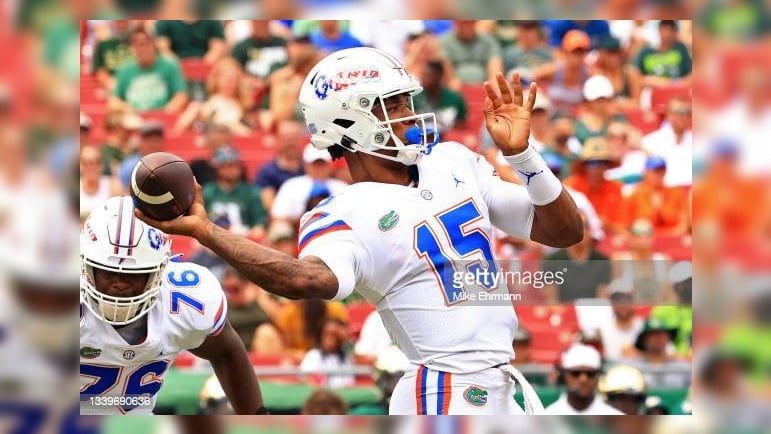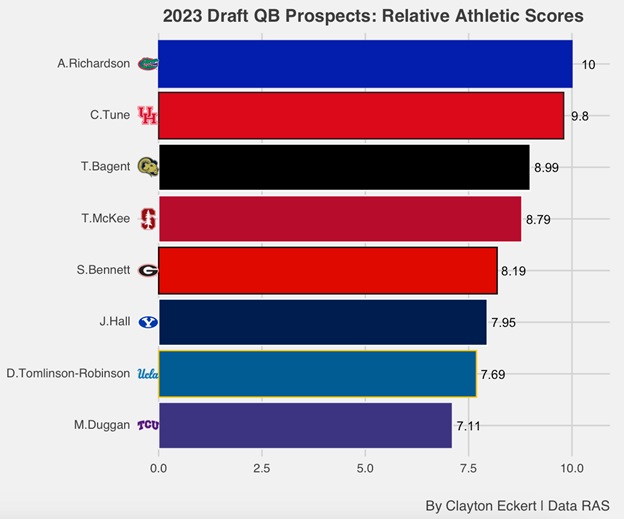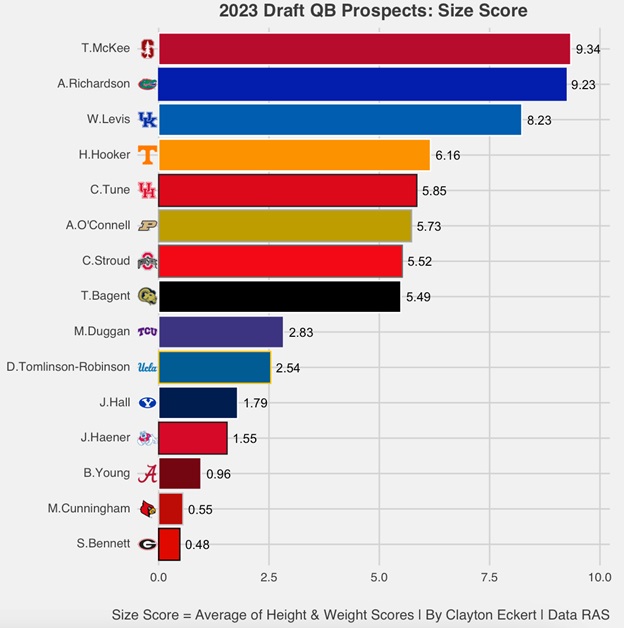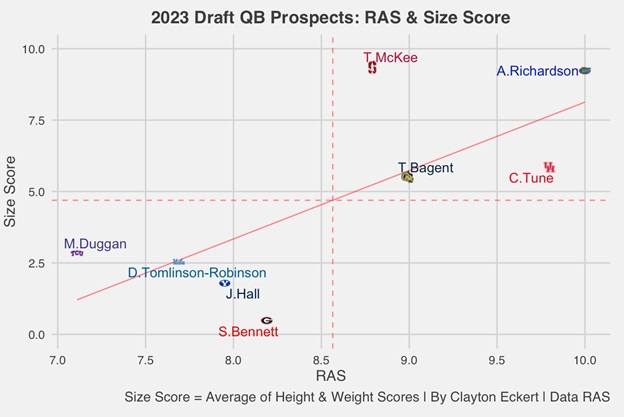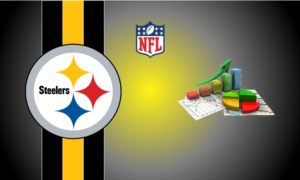Today I want to analyze some great data from Kent Lee Platt’s Relative Athletic Scores (RAS) for the quarterbacks. Here is a link to Platt’s website in case you haven’t seen his work. To qualify for a RAS score, a player must have a total of six recorded metrics from any of the following: Height, Weight, 40-yard dash, 20-yard split, 10-yard split, Bench Press, Vertical Jump, Broad Jump, Short Shuttle, and Three-Cone. The player is then graded on each in comparison to the positional database since 1987 to get more of a feel of their size, speed, explosion, agility, and total value, giving context to the raw numbers.
The goal of the series is to provide the RAS from Platt, with a bit of my own twist with a size score and visualize it to get a simultaneous view of all the players at their position that participated at the combine. Here are the players that qualified for a RAS (NOTE: Positions are grouped from the Combine results tracker compiled by Dave Bryan and Alex Kozora):
Right away we see Florida’s Anthony Richardson with a perfect 10 RAS, with matching individual scores on elite explosion (impressive 40.5 vertical jump and 1009 broad jump), along with historically elite speed (4.43 40-yard dash), and elite size as well (6042, 244) with height being the lowest mark of his incredible workout. One other player had a nine+ RAS, Houston’s Clayton Tune (9.8 RAS). He also impressed, with elite speed and explosion, okay size, but didn’t qualify in agility, with his 1.55 10-yard split his best mark and height (6024) his lowest result.
After a drop off, we see three prospects in the eight range. Shephard’s Tyson Bagent (8.99 RAS) has elite explosion, good speed and agility, and okay size, with a 36” vertical jump his best workout and weight (213) his lowest number. Stanford’s Tanner McKee (8.79 RAS) has elite size, good explosion, okay agility, but didn’t do speed testing, with height (6062) his strongest result and a 4.41 shuttle his lowest mark. Georgia’s Stetson Bennett (8.19 RAS) has elite speed, great explosion, but very poor size and didn’t qualify in agility, with a 1.58 10-yard split his best mark but weight (192) that is concerning for the position.
The final three qualifying prospects land in the sevens, highlighting the shift over time to more athleticism at the position. BYU’s Jaren Hall (7.95 RAS) has elite speed, great agility but very poor size and no explosive testing, with a 1.59 10-yard split his best number and height (6001) his lowest mark. UCLA’s Dorian Thompson-Robinson (7.69 RAS) has elite speed, great explosion, but poor size and agility, with a 1.56 10-yard split his best mark and weight (203) the lowest. The final player is TCU’s Max Duggan (7.11 RAS) who has elite speed, good explosion, but poor size and agility, with a 4.52 40-yard dash his best test and weight (207) his lowest result in the historical database.
Next, I wanted to provide more context with a size score using the RAS for the players height and weight, which includes all the combine invites since all the players are measured:
Right away we see the extreme range of size, with a few prospects that offer it, but far more small prospects which highlights the sacrifice of athletic quarterbacks (in most cases) in today’s NFL. Also, we see many more names, emphasizing the lack of athletic testing at the position. McKee tops this list (6062, 231) but didn’t do speed testing and his 7.21 three-cone is lower than what Pittsburgh has drafted in the past. Richardson ranks second (6042, 244) along with his perfect 10 RAS, but will obviously be long gone by the time Pittsburgh should consider drafting the position.
Only one player lands in the eights: Kentucky’s Will Levis (6037, 229), who pairs his great size (including 10 5/8” hands and 32” arms) with elite explosion (34” vertical and 1004 broad jumps) but didn’t qualify for a RAS with no speed or agility testing. He will likely be an early draft pick.
After a huge drop off of over two points, there’s one player in the sixth tier: Tennessee’s Hendon Hooker (6032, 217), who pairs this good size 10 1/2” hands and 33” arms but didn’t do athletic testing.
Four players land in the five range, starting with Tune (6024, 220). He pairs this with the second ranked 9.8 RAS, fitting Pittsburgh’s recent draft history that shifted with the selection of Chris Oladokun in the 2022 NFL draft, but didn’t participate in the three-cone. Purdue’s Aidan O’Connell (6033, 213) only measured, and has 9 3/4” hands along with 32 1/4” arms. All fit the new precedents at the position for Pittsburgh and is even more likely to be available at the end of the draft, when our team here at Steelers Depot thinks the Steelers may pull the trigger with a selection. Ohio State’s C.J. Stroud (6030, 214) only measured, and has 10” hands along with 32 5/8” arms, fitting the thresholds and will likely be a top two draft pick. Bagent (6031, 213) fits the new size threshold, but an arm length (30 1/8”) that would set a new precedent.
After an even larger drop off, we have two prospects in the twos. including Duggan (6014, 207), who misses the mark in weight, arm length (30 3/8”), and three cone (7.26). Tomlinson-Robinson (6015, 203) also misses in weight, arm length (30 5/8”), and three cone (7.28). Both could be available if Pittsburgh decides to draft the position late in the draft.
Two players land in the one range: Hall (6001, 207) which both miss the mark along with short arms (29 3/4”), and Fresno State’s Jake Haener (5115, 207) which would also set new precedents, along with his arm length (29 3/4), and didn’t qualify for a RAS with no speed or shuttle tests.
Three players have historically poor and concerning size scores below one: Alabama’s Bryce Young (5101, 204) who’s likely a top two pick in spite of this; Louisville’s Malik Cunningham (5116, 192), a likely late-round candidate who would for sure set a new size standard in Pittsburgh and didn’t do the three-cone drill. The final player is Bennett (5113, 192), fitting this bill as well, along with short 28 7/8” arms and didn’t run the three-cone.
To wrap up, here is a visual layering the RAS and size score to take it all in:
Richardson clearly has the best balance of both with his perfect 10 RAS and nine+ size score. Tune’s 9.8 RAS is rather impressive as well along with his above average size. If available late in the draft, he would be the hopeful and best (realistic) fit in Pittsburgh in my opinion. McKee and Bagent land above the mean in both, with the former providing more ideal size and the latter having a bit stronger athleticism. Where the other prospects land is very interesting, with very low size scores and RASs of seven or above, emphasizing the earlier point of the shift to athletic quarterbacks in today’s game. Personally, I prefer Pittsburgh not use a draft pick on the position. If it does, it will be interesting to see if the Steelers follow the small yet athletic trend for the second year in a row at the end of the 2023 draft.
For those who like the numbers, it’s unfortunate a several players didn’t test fully. It will be interesting to continue to see how the men stack up in the coming weeks when Platt updates the site with the unofficial numbers.
What are your thoughts on the data? Thanks for reading and let me know your thoughts in the comments.

